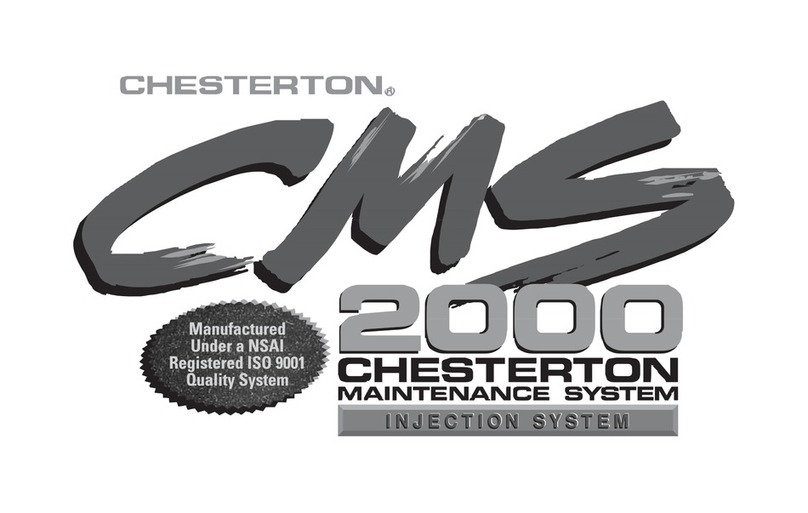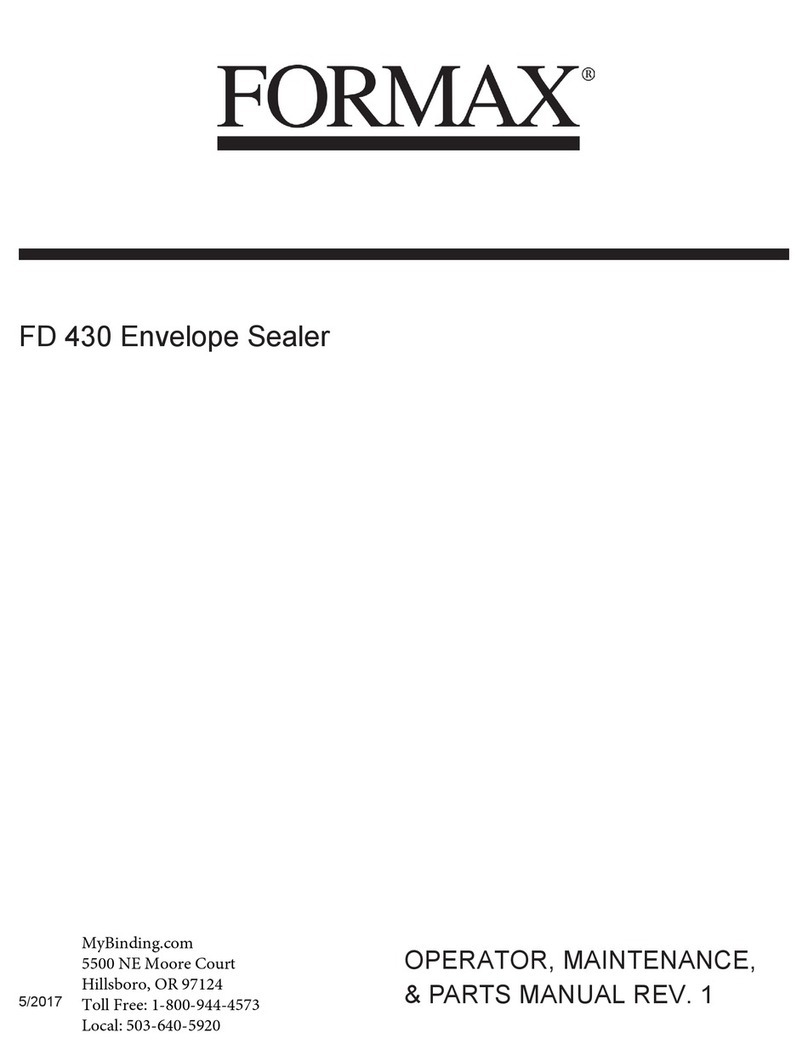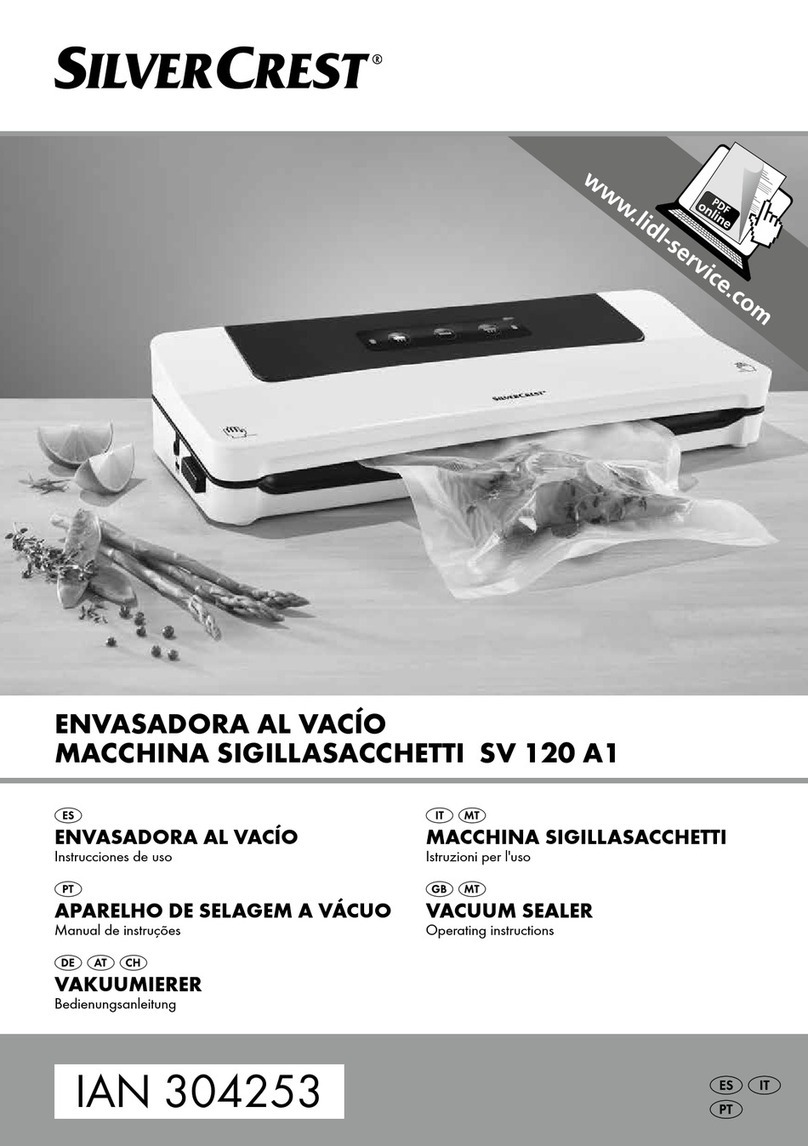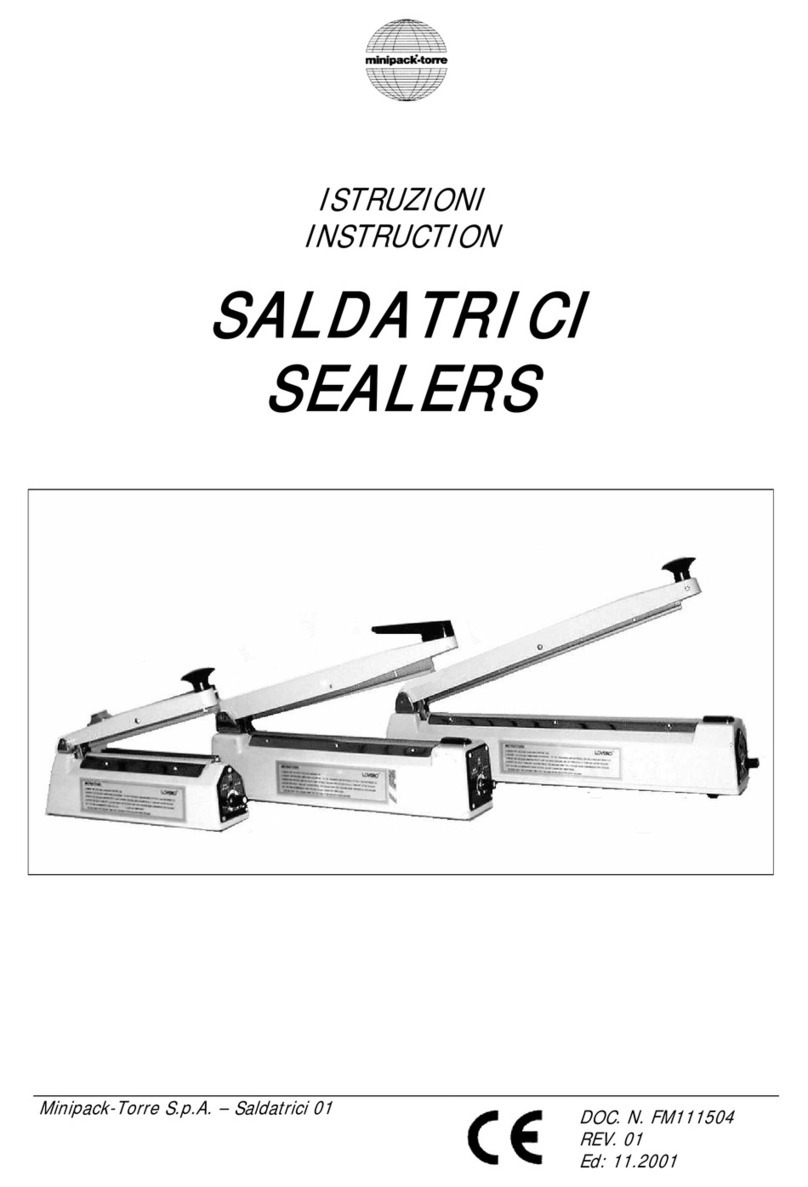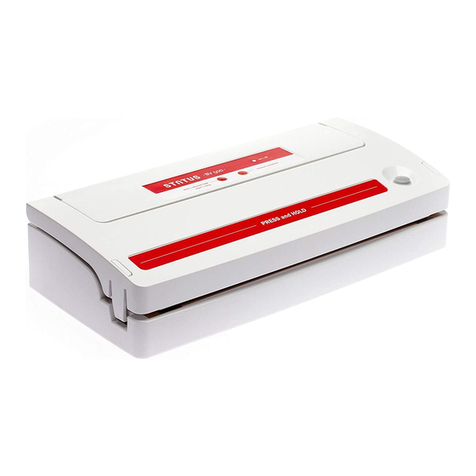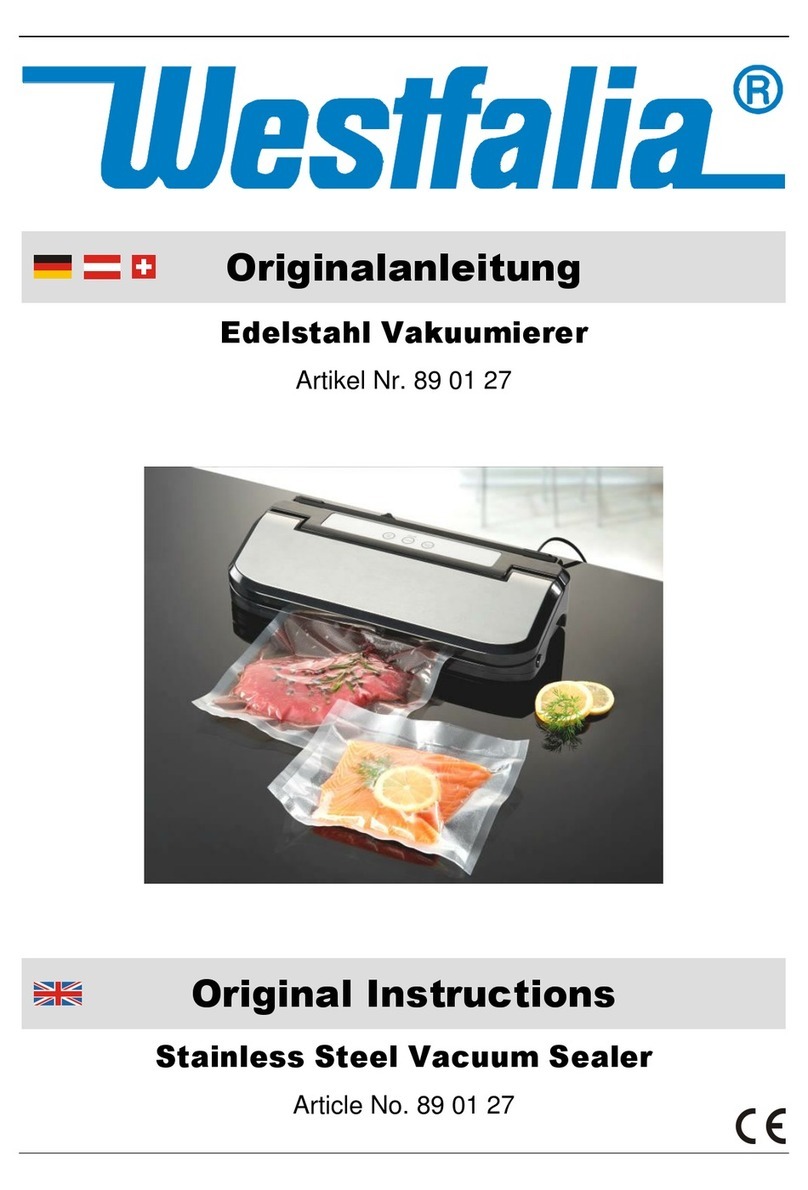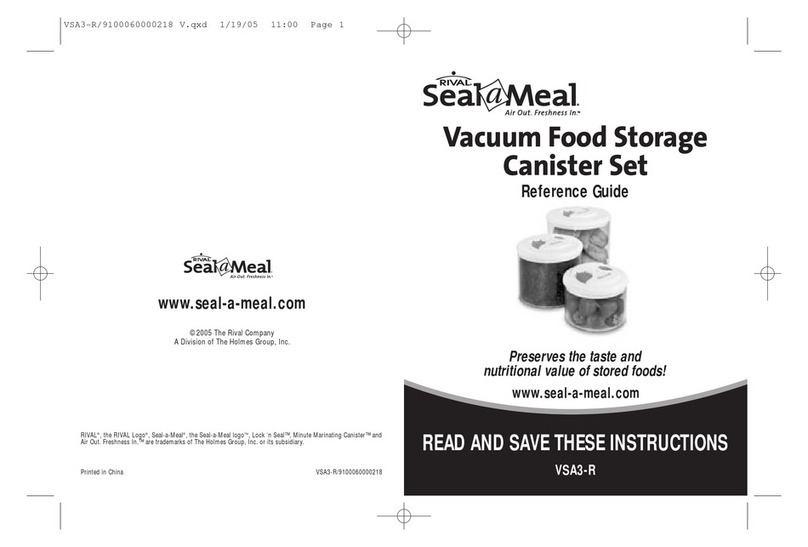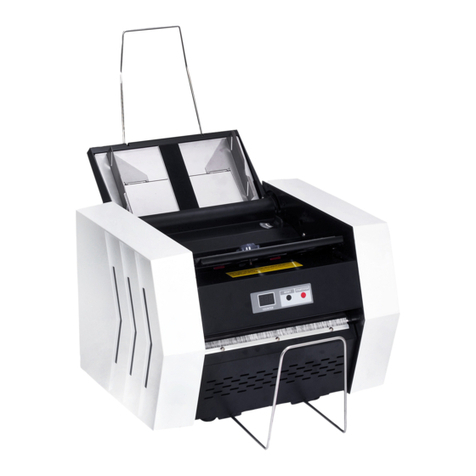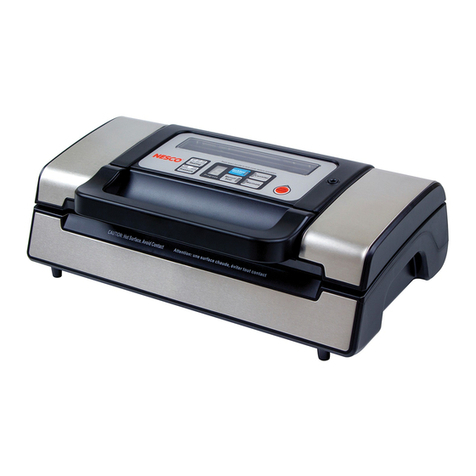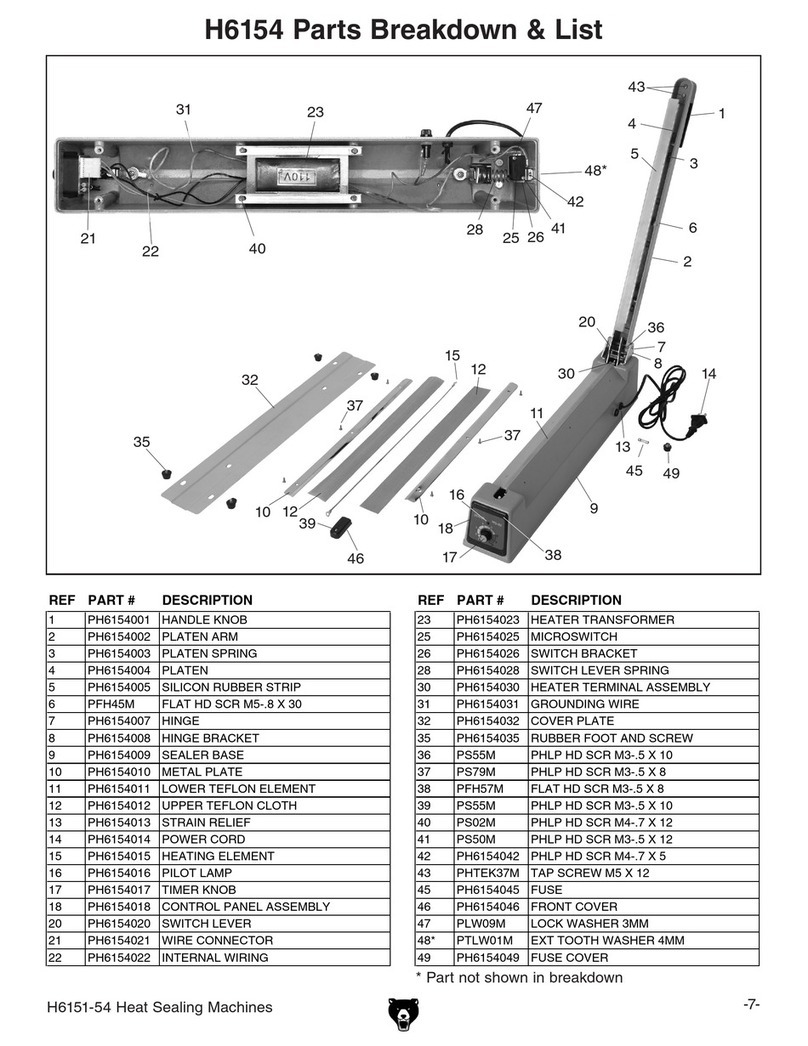Chesterton TwinHydrostatic 4410 Owner's manual

4410 TwinHydrostatic™
Gas Seal
Installation, Operation and Rebuild Instruction
TABLE OF CONTENTS
INSTALLATION, OPERATION and
REBUILD INSTRUCTIONS
Seal Data Reference
(Insert seal and equipment data here for future reference)
ITEM #
SEAL
(Example: 4410 – 50 mm SSC/CB/FKM/S)
INSTALLATION DATE
1.0 Cautions ................................................................... 2
2.0 Transport and Storage .......................................... 2
3.0 Description............................................................... 2
3.1 Parts Identification..........................................................2
3.2 Operating Parameters.....................................................3
3.3 Standard Materials .........................................................3
3.4 Intended Use..................................................................3
3.5 Dimensional Data ..................................................... 3 - 5
4.0 Preparation for Installation ................................... 6
4.1 Equipment .....................................................................6
4.2 4410 TwinHydrostatic™ Gas Seal ...................................6
5.0 Seal Installation................................................. 7 - 8
6.0 Commissioning/Equipment Start-up................. 8
7.0 Decommissioning/Equipment Shut Down ....... 8
8.0 Spare Parts .............................................................. 8
9.0 Seal Maintenance and Repair ..................... 9 - 11
9.1 4410 TwinHydrostatic™ Gas Seal Rebuild .............. 9 - 11

2
These instructions are general in nature. It is assumed
that the installer is familiar with seals and certainly with
the requirements of their plant for the successful use of
mechanical seals. If in doubt, get assistance from someone
in the plant who is familiar with seals or delay the installation
until a seal representative is available. All necessary auxiliary
arrangements for successful operation (heating, cooling,
flushing) as well as safety devices must be employed.
These decisions are to be made by the user. The decision
to use this seal or any other Chesterton seal in a particular
service is the customer’s responsibility.
Transport and store seals in their original packaging.
Mechanical seals contain components that may be subject to
alteration and ageing. It is therefore important to observe the
following conditions for storage:
Do not touch the mechanical seal for any reason while it is
operating. Lockout or uncouple the driver prior to personal
contact with the seal. Do not touch the mechanical seal
while it is in contact with hot or cold fluids. Ensure that all
the mechanical seal materials are compatible with the
process fluid. This will prevent possible personal injury.
• Dust free environment
• Moderately ventilated at room temperature
• Avoid exposure to direct sunlight and heat.
• For elastomers, storage conditions according to
ISO 2230 should be observed.
1.0 CAUTIONS
2.0 TRANSPORT AND STORAGE
3.0 DESCRIPTION
3.1 Parts Identification
Figure 1
1
2
3
4
5
6
7
8
9
10
12
11
13
14
15
16
KEY
1 – Diaphragm
2 – Adapter
3 – Adjustment Spring
4 – Adjustment Screw O-Ring
5 – Adjustment Screw
6 – Retaining Clip
7 – Filter Disk
8 – Inner Gland O-Ring
9 – Rotary Outside Diameter O-Ring
10 – Gasket
11 – Stationary O-Ring
12 – Rotary Support O-Ring
13 – Sleeve O-Ring
14 – Rotary Seal Face
15 – Stationary Seal Face
16 – Sleeve Assembly
17 – Gasket (Diaphragm)
18 – Seat O-Ring
19 – Actuator
20 – O-Ring Seat
21 – Spring Cylinder O-Ring
22 – Ball
23 – Ball Spring
24 – Spring Cylinder
25 – Gland Bolts (Not shown)
26 – Button Head Cap Screw
27 – Gland
28 – Socket Head Cap Screw
29 – Centering Clip
30 – Lock Ring
31 – Load Spring
32 – Pusher Outside Diameter O-Ring
33 – Cup Point Set Screw
34 – Dog Point Set Screw (Not shown)
35 – Pusher
36 – Pusher Inside Diameter O-Ring
37 – 1/4" Pipe Plug (Not shown)
38 – 1/4" Pipe Plug (Large) (Not shown)
3/8" Pipe Plug (Extra Large) (Not shown)
39 – 1/4" Cap Plug (Not shown)
17
18
19
20
21
22
23
24,
25
26
27
28
29
30
31
32
33,
34
35
36
(not shown)
(not shown)

3
3.0 DESCRIPTION cont.
3.2 Operating Parameters*
Speed Limits:
0 to 1500 FPM (8 mps) Wet Operation
0 to 360 FPM (2 mps) Dry Operation
Pressure Limits:
Vacuum to 10 bar g (150 psig)
Temperature Limits:
150°C (300°F) EPDM
205°C (400°F) FKM; FEPM
260°C (500°F) FFKM
Gas lubricated WET Operation
has liquid product in contact with the seal components.
Gas lubricated DRY Operation
has gas product in the vicinity of the seal components.
* Consult Chesterton Mechanical Seal Application Engineering for conditions
beyond these limits.
3.3 Standard Materials
Faces:
Carbon Rotary Seal Ring/Sintered Silicon Carbide Stationary
Seal Ring (Wet or Dry Operation)
Graphited Silicon Carbide Rotary Seal Ring/ Graphited
Silicon Carbide Stationary Seal Ring (Wet Operation Only)
Elastomers:
FKM, EPDM, FEPM, FFKM
Metal Parts:
316 SS/EN 1.4401 body
Alloy C276/EN 2.4819 springs and drive pins
Hardened set screws (standard)
3.4 Intended Use
The mechanical seal is specifically designed for the intended
application and is to be operated within the operating
parameters as specified. For use beyond the intended
application and/or outside the operating parameters, consult
Chesterton to confirm the suitability of the mechanical seal
prior to putting the mechanical seal in operation.
3.5 Dimensional Data (Drawings)
KEY (drawings and charts)
A – Shaft Size
B – Maximum Gland Diameter
C – Stuffing Box Inside Diameter
E – Required Stuffing Box Depth
F – Outboard Seal Length
G – Minimum Bolt Circle by Bolt Size
H – Slot Width
T – Sleeve O-Ring
U – Rotary Support O-Ring
V – Rotary (outside diameter) O-Ring
W – Inter Gland O-Ring
X – Stationary O-Ring
Y – Pusher (outside diameter) O-Ring
Z – Pusher (inside diameter) O-Ring
ø
A
V
U
T
W
X
Y
Z
E MIN F MAX
ø
C
H
ø
B MAX
ø
G MIN

4
3.0 DESCRIPTION cont.
3.5 Dimensional Data (cont.) – Table 1
METRIC - Millimeters
SHAFT
SIZE
METRIC
SHAFT
SIZE
INCH
GLAND
OUTSIDE
DIAMETER
STUFFING
BOX
BORE
STUFFING
BOX
DEPTH
OUT-
BOARD
LENGTH
BOLT CIRCLE
BY BOLT SIZE
SLOT
WIDTH
O-RINGS
SHAFT
ROTARY
GLAND
ADAPTER
PUSHER
SUPPORT
OUTSIDE
DIAMETER STATIONARY
OUTSIDE
DIAMETER
INSIDE
DIAMETER
A B
MAX
C
MIN
C
MAX
E
MIN
F
MAX
G MIN H T U V W X Y Z
12 mm 16 mm 20 mm
65 mm 2.559 180 91 106 10 71 133 136 18 -230 -236 -240 -244 -241 -238 -235
70 mm 2.756 183 95 109 10 71 137 140 18 -232 -237 -241 -245 -242 -239 -236
75 mm 2.953 190 101 116 10 71 144 148 18 -234 -239 -243 -247 -244 -241 -238
80 mm 3.150 196 107 122 10 71 151 154 18 -236 -241 -245 -249 -246 -243 -240
85 mm 3.346 199 111 125 10 71 153 157 160 21 -237 -242 -246 -250 -247 -244 -241
90 mm 3.543 206 117 132 10 71 160 163 166 21 -239 -244 -248 -252 -249 -246 -243
95 mm 3.74 209 120 135 10 71 162 165 168 21 -240 -245 -249 -253 -250 -247 -244
100 mm 3.937 215 126 141 10 71 170 173 176 21 -242 -247 -251 -255 -252 -249 -246
110 mm 4.331 225 136 151 10 71 179 182 186 21 -245 -250 -254 -258 -255 -252 -249
120 mm 4.724 234 145 161 10 71 189 193 196 21 -248 -253 -257 -260 -258 -255 -252
22 mm 24 mm 28 mm
125 mm 4.921 283 160 192 15 102 233 236 239 † -353 -361 -363 -263 -364 -362 -360
130 mm 5.118 289 167 198 15 102 239 242 246 † -354 -362 -364 -264 -365 -363 -361
135 mm 5.315 296 173 204 15 102 246 249 252 † -356 -363 -365 -265 -366 -364 -362
140 mm 5.512 296 173 204 15 102 246 249 252 † -358 -363 -365 -265 -366 -364 -362
145 mm 5.709 302 179 211 15 102 252 255 258 † -359 -364 -366 -266 -367 -365 -363
150 mm 5.906 309 186 217 15 102 258 261 265 † -361 -365 -367 -267 -368 -366 -364
155 mm 6.102 315 192 224 15 102 265 268 271 † -362 -366 -368 -268 -369 -367 -365
160 mm 6.299 321 199 230 15 102 271 274 277 † -362 -367 -369 -269 -370 -368 -366
165 mm 6.496 321 199 230 15 102 271 274 277 † -363 -367 -369 -269 -370 -368 -366
170 mm 6.693 328 205 236 15 102 277 281 284 † -364 -368 -370 -270 -371 -369 -367
175 mm 6.89 334 211 243 15 102 284 287 290 † -365 -369 -371 -271 -372 -370 -368
180 mm 7.087 340 218 249 15 102 290 293 296 † -366 -370 -372 -272 -373 -371 -369
185 mm 7.283 347 224 255 15 102 296 300 303 † -366 -371 -373 -273 -374 -372 -370
190 mm 7.480 347 224 255 15 102 296 300 303 † -367 -371 -373 -273 -374 -372 -370
195 mm 7.677 353 230 262 15 102 303 306 309 † -368 -372 -374 -274 -375 -373 -371
† Note:1. Bolt Circle Manufactured to Customer Specifications

5
3.0 DESCRIPTION cont.
3.5 Dimensional Data (cont.) – Table 1
INCH
SHAFT
SIZE
METRIC
SHAFT
SIZE
INCH
GLAND
OUTSIDE
DIAMETER
STUFFING
BOX
BORE
STUFFING
BOX
DEPTH
OUT-
BOARD
LENGTH
BOLT CIRCLE
BY BOLT SIZE
SLOT
WIDTH
O-RINGS
SHAFT
ROTARY
GLAND
ADAPTER
PUSHER
SUPPORT
OUTSIDE
DIAMETER STATIONARY
OUTSIDE
DIAMETER
INSIDE
DIAMETER
A B
MAX
C
MIN
C
MAX
E
MIN
F
MAX
G MIN H T U V W X Y Z
12 mm 16 mm 20 mm
-21 2.625 7.1 3.6 4.16 0.4 2.8 5.25 5.37 0.69 -231 -236 -240 -244 -241 -238 -235
-22 2.75 7.22 3.73 4.29 0.4 2.8 5.38 5.5 0.69 -232 -237 -241 -245 -242 -239 -236
-23 2.875 7.35 3.85 4.41 0.4 2.8 5.49 5.62 0.69 -233 -238 -242 -246 -243 -240 -237
-24 3 7.47 3.98 4.57 0.4 2.8 5.69 5.81 0.69 -234 -239 -243 -247 -244 -241 -238
-25 3.125 7.6 4.1 4.68 0.4 2.8 5.8 5.92 0.69 -235 -240 -244 -248 -245 -242 -239
-26 3.25 7.72 4.23 4.82 0.4 2.8 5.94 6.06 0.69 -236 -241 -245 -249 -246 -243 -240
-27 3.375 7.85 4.35 4.93 0.4 2.8 6.04 6.17 6.29 0.81 -237 -242 -246 -250 -247 -244 -241
-28 3.5 7.97 4.48 5.07 0.4 2.8 6.18 6.31 6.43 0.81 -238 -243 -247 -251 -248 -245 -242
-29 3.625 8.1 4.6 5.19 0.4 2.8 6.29 6.42 6.54 0.81 -239 -244 -248 -252 -249 -246 -243
-30 3.75 8.22 4.73 5.3 0.4 2.8 6.38 6.51 6.63 0.81 -240 -245 -249 -253 -250 -247 -244
-31 3.875 8.35 4.85 5.41 0.4 2.8 6.5 6.62 6.75 0.81 -241 -246 -250 -254 -251 -248 -245
-32 4 8.47 4.98 5.57 0.4 2.8 6.68 6.81 6.93 0.81 -242 -247 -251 -255 -252 -249 -246
-33 4.125 8.6 5.1 5.69 0.4 2.8 6.79 6.92 7.04 0.81 -243 -248 -252 -256 -253 -250 -247
-34 4.25 8.72 5.23 5.82 0.4 2.8 6.93 7.05 7.18 0.81 -244 -249 -253 -257 -254 -251 -248
-35 4.375 8.85 5.35 5.94 0.4 2.8 7.05 7.18 7.3 0.81 -245 -250 -254 -258 -255 -252 -249
-36 4.5 8.97 5.48 6.07 0.4 2.8 7.18 7.3 7.43 0.81 -246 -251 -255 -259 -256 -253 -250
-37 4.625 9.1 5.6 6.19 0.4 2.8 7.3 7.43 7.55 0.81 -247 -252 -256 -259 -257 -254 -251
-38 4.75 9.22 5.73 6.33 0.4 2.8 7.46 7.59 7.71 0.81 -248 -253 -257 -260 -258 -255 -252
7/8" 1" 1 1/8"
-40 5 11.15 6.32 7.55 0.6 4 9.17 9.3 9.42 † -353 -361 -363 -263 -364 -362 -360
-42 5.25 11.4 6.57 7.8 0.6 4 9.42 9.55 9.67 † -355 -362 -364 -264 -365 -363 -361
-44 5.5 11.65 6.82 8.05 0.6 4 9.67 9.8 9.92 † -357 -363 -365 -265 -366 -364 -362
-46 5.75 11.9 7.07 8.3 0.6 4 9.92 10.05 10.17 † -359 -364 -366 -266 -367 -365 -363
-48 6 12.15 7.32 8.55 0.6 4 10.17 10.3 10.42 † -361 -365 -367 -267 -368 -366 -364
-50 6.25 12.4 7.57 8.8 0.6 4 10.42 10.55 10.67 † -362 -366 -368 -268 -369 -367 -365
-52 6.5 12.65 7.82 9.05 0.6 4 10.67 10.8 10.92 † -363 -367 -369 -269 -370 -368 -366
-54 6.75 12.9 8.07 9.3 0.6 4 10.92 11.05 11.17 † -364 -368 -370 -270 -371 -369 -367
-56 7 13.15 8.32 9.55 0.6 4 11.17 11.3 11.42 † -365 -369 -371 -271 -372 -370 -368
-58 7.25 13.4 8.57 9.8 0.6 4 11.42 11.55 11.67 † -366 -370 -372 -272 -373 -371 -369
-60 7.5 13.65 8.82 10.05 0.6 4 11.67 11.8 11.92 † -367 -371 -373 -273 -374 -372 -370
-62 7.75 13.9 9.07 10.3 0.6 4 11.92 12.05 12.17 † -368 -372 -374 -274 -375 -373 -371
-64 8 14.15 9.32 10.55 0.6 4 12.17 12.3 12.42 † -369 -373 -375 -274 -376 -374 -372
† Note:1. Bolt Circle Manufactured to Customer Specifications

6
1 If practical, place the dial indicator tip
on the end of the shaft sleeve or on a
step in the shaft to measure end play.
Alternately push and pull the shaft in
the axial direction. If the bearings are
in good condition, end play should not
exceed 0,13 mm (.005").
3 Remove all sharp corners, burrs, and
scratches on the shaft, especially in
areas where the O-Ring will slide, and
polish if necessary to achieve a 0,8
micron (32 microinch) Ra finish. Make
sure the shaft or sleeve diameter is
within 0,05 mm (.002") of nominal.
4 Use a dial indicator to measure the
shaft runout in the area where the seal
will be installed. Runout should not
exceed 0,001 mm TIR per millimeter
(.001 inch TIR per inch) of shaft
diameter.
5 Protect the shaft O-Ring by lubricating
the shaft with a clean silicone based
lubricant, such as that provided with
the seal.
6 Check availability of clean dry barrier
gas. The seal uses gas (Nitrogen) to
seal the product from the environment
and lubricate the seal faces. 7.4 NL/m
(15 SCFH) of barrier gas must be
available at 2 bar (30 psi) over the
maximum stuffing box pressure and
filtered to a maximum particle size of
3 microns with a dew point of <-29°C
(-20°F). Alternate gas can be used for
barrier gas supply if it is compatible
with the product and the environment.
4.0 PREPARATION FOR INSTALLATION
4.1 Equipment
.005"
0,13 mm
<
ø
1000
ø
<
32 µ"
0,8 µmRa
ø
<
.002"
0,05 mm
±
2 If possible, attach a base dial indicator
to the shaft and rotate both the
indicator and shaft slowly while reading
the runout of the stuffing box face.
Misalignment of the stuffing box face
relative to the shaft should not exceed
0,005 mm TIR per mm (.005 in per
inch) of shaft diameter.
The stuffing box face must be flat
and smooth enough to seal the
gland. Surface roughness should
be 3,2 microns (125 microinch) Ra
maximum for gaskets and 0,8 micron
(32 microinch) Ra for O-Rings. Steps
between halves of split case pumps
should be machined flat. Make sure
the stuffing box is clean and clear
along its entire length.
ø
ø
200
<
125 µ"
3,2 µm
4.2 4410 TwinHydrostatic™
Gas Seal
1. Review seal packaging ensuring no
damage or shortage has occurred to
the contents.
2. Review the seal fit dimensions in Table 1
to ensure the equipment to be sealed
has the required dimensions.
3. On the cover page, record the seal
Item Number and Name found on the
label for referencing when contacting
A.W. Chesterton Application Engineering.
4. Check the chemical listing to determine
if the O-Rings installed in this seal are
compatible with the fluid being sealed.
5. The dog point set screws go into
the small holes in the sleeve. Do not
disengage these screws from the sleeve
when positioning the seal.
The cup point set screws go through the
larger holes in the sleeve.
IMPORTANT: There are three (3) ¼"
dog point set screws and 6 cup point
set screws for sizes from 2 5/8" to 4 ¾"
(65 mm – 120 mm) and three (3) ¼" dog
point set screw and 9 cup point set
screws for sizes from 5" to 8" (125 mm –
200 mm).
6. To reposition or remove the seal, make
sure all the centering clips and socket
head cap screws are engaged.
IMPORTANT: There are 3 centering slips
for sizes from 2 5/8" to 4 ¾" (65 mm -120
mm) and 6 centering clips from sizes
from 5" to 8" (125 mm – 200 mm).
7. Centering clips have been preset at the
factory. If for any reason you loosen or
remove the centering clip cap screw,
retighten as follows prior to installing
the seal on the equipment: Tighten the
cap screw finger tight.; then using a
hex wrench, tighten the cap screw an
additional 1/8 turn. This will approximate
the 40 inch-pounds of torque for 5" to 8"
(125 mm – 200 mm ) set at the factory.
8. Make sure that the lip on the end of the
gland is inside the inner centering clip
groove and the lock ring lip engages the
outer centering clip groove.
CAUTION: The cup point set screw
installed in the lock ring are hardened
steel to ensure that the seal maintains
position with the higher axial loads
associated with the use of gas seals.
Slide the seal onto the shaft making sure
the dog point set screws are engaged in
and not through the sleeve.

7
1. Slide the completely assembled 4410
seal onto the shaft by pushing on the
lock ring. Make sure that all the set
screw are engaged in the sleeve but
do not protrude into the sleeve inside
diameter bore.
2. Reassemble the pump and make
necessary shaft alignments and
impeller adjustments.
3. Orient the flush and barrier gas
supply connection to the location
required (see TABLE 2). The ports
are plugged prior to shipping.
CAUTION: Shipping plugs limit
the dirt and contamination which
could enter the seal and cause
seal malfunction. When plugs are
removed ensure that dirt, liquid
and contamination do not enter the
seal ports.
TABLE 2 – Gland Port Functions
PORT LABEL PORT FUNCTION
“S” Barrier Gas Supply
“F” Flush - Environmental
“BG” Monitor Face Pressure
“CG” Monitor Closing Pressure
“X” Manufacturing Port (Do Not Use)
4. Piping connections should not be
made prior to tightening the stuffing
box bolts.
5. Tighten the stuffing box bolts evenly.
IMPORTANT: The stuffing box
bolts must be tightened before
tightening the set screws onto
the shaft.
6. IMPORTANT: All the dog point set
screws must be tightened FIRST
in order. See Seal Maintenance
and Repair step 14 for location of
dog point set screws. If rotation of
the lock ring is required for tightening
set screws, loosen or remove one
centering clip. Once the dog point
set screws are tightened, evenly
tighten the cup point set screws to
the shaft in order, with the hex key
provided. After all set screws have
been tightened by hand, retighten the
set screws with a torque wrench to
values shown in TABLE 3.
7. Remove socket head cap screws
and the centering clips. Retain for
later use.
8. IMPORTANT: It is important
to make sure that the gland is
properly centered over the sleeve.
To do this, turn the shaft by hand to
make sure the seal turns freely. If you
hear metal to metal contact within
the seal, it was improperly centered.
Re-install the centering clips finger
tight. Loosen the gland bolts. Fully
tighten clips. Loosen the set screws.
Re-tighten the gland bolts. Re-tighten
the set screws. Remove the clips.
If metal to metal contact still exists
check the centering of the stuffing
box.
9. THE GAS SUPPLY PORTS ARE 1/4"
NPT. THE FLUSH CONNECTIONS
ARE 1/4" NPT FOR SIZES FROM
2 5/8" TO 4 3/4" (65 mm –120 mm)
AND 3/8" NPT FOR THE SIZES
FROM 5" TO 8" (125 mm – 200
mm).
10. Determine if a flush/recirculation
port is required. The flush (marked
“F”) connection is the NPT port on
the outer diameter of the adapter
housing (inner gland). If so, remove
the shipping plug and connect
the pump discharge or suction to
the flush port using a recirculation
line(bleed from discharge [API Plan
11] or connect to suction [API Plan
13]). This is recommended in seal
applications where the gas supply
may be lost during operation. Plug the
flush port if no connection is used.
This connection may also be used
to monitor stuffing box pressure by
installing a connection to a pressure
gauge.
11. The gas supply port is marked with
an “S” on the outer diameter of the
gland. See Seal Assembly and Repair
steps 22 and 24 for location of the
gas supply port. Supply gas is to be
connected to the gas supply port
by removing the shipping plugs and
installing a 1/4" NPT connection from
the gas supply system. Purge the
gas supply line prior to connecting
to the seal port to insure it is free
of contamination, dirt and liquid.
Insure no burrs, restrictions or liquid
legs are present in the supply line.
Opposite the gas supply port are
two 1/4" NPT gauge ports marked
with “BG” and “CG” on the outer
diameter of the gland, which may be
utilized for monitoring the barrier and
closing pressure respectively. See
Seal Assembly and Repair step 25
for location of the pressure gauge
ports. IMPORTANT: The gas supply
must be on whenever the pump is
pressurized or contains product.
Full pressure supply gas can be piped
directly to the gas supply port. The
seal Dual In-Gland Control System
(DIGCS) will maintain the preset
differential pressures between the
barrier gas and process fluid (~ 20
psi), and between closing gas and
process fluid (~ 25 psi) respectively.
IMPORTANT: The pressure
differentials can be adjusted
by tightening or loosening the
hex head adjustment screws on
the side of the adapter (inner
gland housing) for desired flow
consumption. Make sure the
closing pressure IS EQUAL OR
HIGHER than the barrier pressure
AT ALL TIMES or seal failure
may result. CAUTION: Operation
without sufficient gas supply can
cause a loss in seal performance
or failure.
12. Take all necessary precautions and
follow normal safety procedures
before starting the equipment.
13. The 4410 Barrier and closing
pressure controls may be adjusted
at startup to obtain optimum seal
performance and gas usage. The hex
head adjustment screws (5/16" for
5.0 SEAL INSTALLATION
TABLE 3 – Recommended Torque Values
Seal Size Dog Point & Cup Point Set Screws Stuffing Box Bolts*
Torque Wrench Size
65 mm to 120 mm
(2.625" up to 4.875")
7,3 - 8,3 N-m
(65 - 75 in-lbf) 4 mm 34 - 48 N-m
(25 - 35 ft-lbf)
125 mm to 200 mm
(5.00" to 8")
13.5 - 15.2 N-m
(120 - 135 in-lbf) 5 mm 34 - 48 N-m
(25 - 35 ft-lbf)
* Typical Values; to be adjusted for each application.

8
6.0 COMMISSIONING / EQUIPMENT START UP
7.0 DECOMMISSIONING / EQUIPMENT SHUT DOWN
8.0 SPARE PARTS
1. If possible, turn the shaft by hand to ensure free rotation with
no shaft binding. A slight drag may be found due to the seal
faces but the shaft should rotate freely.
2. Ensure the pump is primed and all piping connections
are correctly fitted and fittings are leak-free. Fill and vent
the equipment in accordance with the instructions of the
equipment manufacturer. Ensure barrier gas is connected
and available to the 4410 gas seal.
3. Before starting the equipment, ensure all nuts and screws
are securely fastened.
4. Take all necessary precautions and follow normal safety
procedures before starting the equipment.
Please Contact Chesterton Mechanical Seal Application Engineering for assistance
regarding gas seals.
Ensure that the equipment is electrically isolated. If the
equipment has been used on toxic or hazardous fluids, ensure
that the equipment is correctly decontaminated and made safe
prior to commencing work. Ensure that the pump is isolated
and check that stuffing box is drained from any fluid and
pressure is fully released. Dismantle the equipment according
to the equipment instruction manual and remove the seal in the
reverse order to installation. In case of disposal, ensure the local
regulations and requirement for disposal or recycling of the
different components in the seal are adhered to.
Use only Chesterton original spare parts. Use of non-original
spare parts represents risk of failure, danger to persons/
equipment and voids the product warranty.
Spare Parts Kit can be purchased from Chesterton, referencing
the recorded seal data from cover page.
In Gland Control System Rebuild/Spare Parts Kit must be
ordered separate from 4410 TwinHydrostatic Gas Seal Rebuild/
Spare Parts Kit. Reference the recorded seal data from cover
page when ordering IGCS Rebuild/Spare Parts Kit.
5.0 SEAL INSTALLATION cont.
sizes from 2 5/8" to 4 3/4" (65 mm-120 mm); 7/16" for sizes
from 5" to 8" (125 mm-200 mm) are located on the inner
side of the seal housing and are marked with a “B” and “C”
for barrier and closing adjustment respectively. The barrier
gas pressure as referenced above must be above the vessel
or stuffing box pressure in the range of 11 to 23 psi (0,7-
1,6 Bar) differential. The closing pressure monitored on the
“CG” port must always be higher than the barrier pressure
monitored on the “BG” port. The flowmeter installed in the
barrier gas supply line should indicate a flow (1 SCFH/0.5
Nl/min minimum to 5 SCFH/2.5 Nl/min) to the seal during
operation.
The barrier gas usage may vary during start-up and
changing conditions and should not exceed 10 SCFH (5.0
Nl/min). In the event of high barrier gas usage readings, after
the gas seal system has stabilized, an adjustment of the
“B” adjustment screw can be made to decrease the barrier
gas pressure and therefore the usage. In the event of low
barrier gas usage readings on the flowmeter an adjustment
of the “C” adjustment screw can be made to decrease the
closing gas pressure and therefore increase the gas usage.
Do not decrease closing gas pressure below the barrier gas
pressure.

10
10 12
13 14 15
17 18
30
33
27
16
19
24
24
17
17
27
19
20
22
18
16
21
27
23
29
11
27
33
34
28
34
11
16
~ 10 X
30
27 27
15
8
9.0 SEAL MAINTENANCE AND REPAIR cont.

FORM NO. 080079 REV 4 4/16
860 Salem Street
Groveland, MA 01834 USA
Telephone: 781-438-7000 Fax: 978-469-6528
www.chesterton.com
© 2016 A.W.Chesterton Company.
® Registered trademark owned and licensed by
A.W.Chesterton Company in USA and other countries.
Chesterton ISO certificates available on www.chesterton.com/corporate/iso
DISTRIBUTED BY:
Table of contents
Other Chesterton Food Saver manuals



